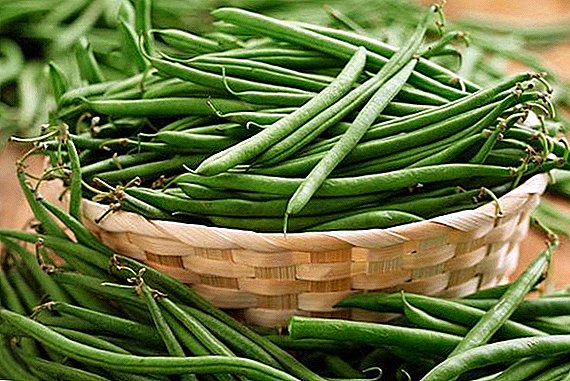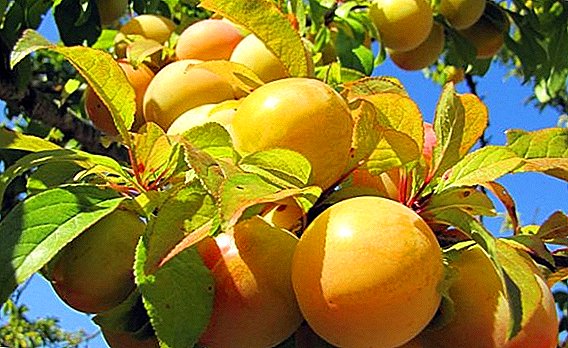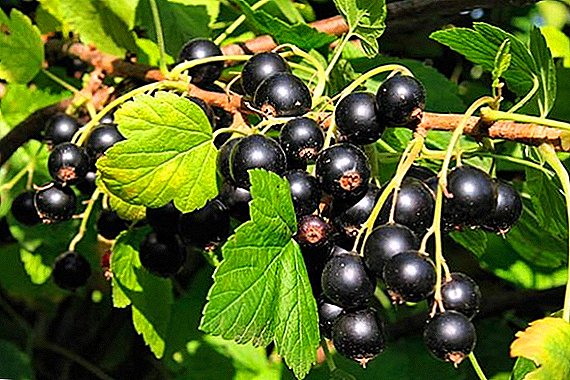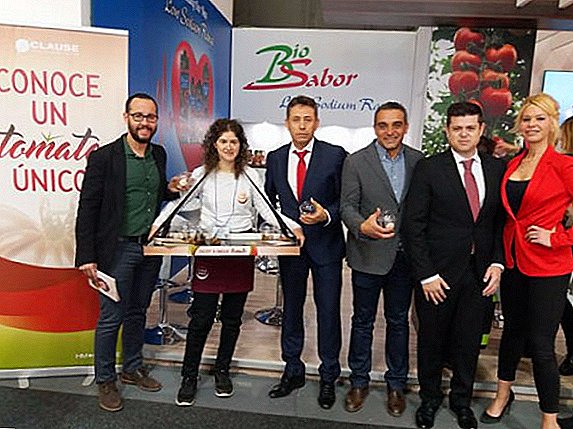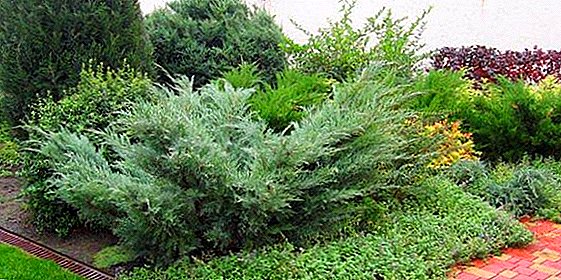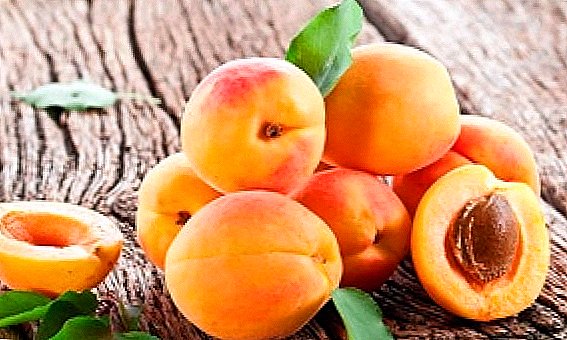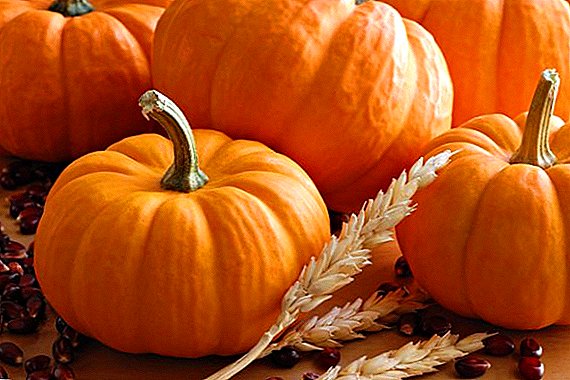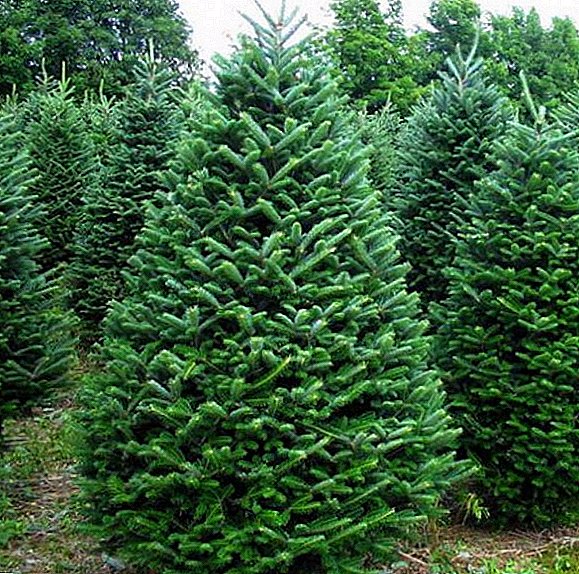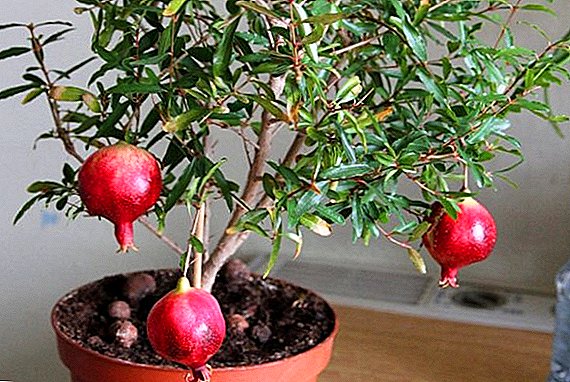 Many exotic plants today are successfully grown in the climatic conditions of the middle zone, so there is nothing strange in the fact that, along with peaches or persimmons, pomegranate can also be found in summer cottages. Is it so easy to grow a southern "guest" on our land and what you need to know about the rules of such an occupation - you will learn from this article.
Many exotic plants today are successfully grown in the climatic conditions of the middle zone, so there is nothing strange in the fact that, along with peaches or persimmons, pomegranate can also be found in summer cottages. Is it so easy to grow a southern "guest" on our land and what you need to know about the rules of such an occupation - you will learn from this article.
Description of pomegranate
As in the description of any other fruit-bearing plant, when characterizing a pomegranate, it is necessary to pay attention not only to the plant itself, but also to its fruits, which we will now do. 
Bush
Common pomegranate is a dense, leafy shrub, often growing to two or even four meters.
Most often, such plants have a smooth central trunk, with many side branches, although with regular pruning the shrub can be easily transformed into a standard garden tree with a very attractive appearance.
You may also be interested to learn about the cultivation of such exotic plants as nerta, annona, rambutan, citrofortunella, anguria, pawpaw, feijoa, luffa, guava, orange, lemon, pomelo, grapefruit, suite.
All light green, oval sheet plates have a characteristic smoothness and brilliance, and with good care they can reach 4 centimeters in length. Pomegranate can be seen blooming from May until September, and bright and large orange-red flowers surely will not leave you indifferent.
All of them are single, with many stamens in the central part and about 6 cm in diameter. Most of all formed flowers do not give ovaries, and only 5% of their total amount is pollinated.  However, due to the long flowering and fruiting, pomegranates may well be used to decorate the territory of the villa or garden, acting as an ornamental plant.
However, due to the long flowering and fruiting, pomegranates may well be used to decorate the territory of the villa or garden, acting as an ornamental plant.
Did you know? In ancient Egypt, pomegranate fruits were placed in the sarcophagi of the departed rulers, because it was believed that they were able to bestow a new life. The plant was called - "the tree of life."
Fruit
With good care for the cultivars of the plant, you can wait for relatively large fruits with a diameter of 5 to 12 cm. They have always smooth skin, but the color can vary from rich brown to purple-red.
Throughout the time of growth and development, garnets do not change color, which is why it is quite difficult to determine their true maturity without removing the peel.
Inside the fruit contains a large number of seeds, each of which is enclosed in bright red or pink flesh with a thin shell.  It is this flesh that is used for nutritional purposes, because, in addition to its fairly high taste, it also has a beneficial vitamin composition.
It is this flesh that is used for nutritional purposes, because, in addition to its fairly high taste, it also has a beneficial vitamin composition.
Where do grenades grow?
The land of the pomegranate is considered to be the territory of the southeastern part of Europe and Asia, although according to archaeological excavations, these trees were successfully grown by the ancient Egyptians and Iranians, and were also known in Babylon and India.
Widespread in Spain, the pomegranate moved to Mexico and California, where missionaries brought it.
As for the present, in the wild and cultural species the plant is found in the territories of Transcaucasia, Uzbekistan, Tajikistan and Azerbaijan, although it can be successfully grown in regions with a temperate and tropical climate, or even in areas with a rather cold winter and hot dry summer. 
Important! The frost resistance of pomegranate is slightly higher than that of citrus fruits, so it is able to tolerate temperature drops to -12 ° C, without significant damage.
Is it possible to grow in the country?
Given all the above, we can assume that in the suburban areas of the middle zone of the described plant should take root well.
However, one should not forget that this is a heat-loving crop, therefore, a grenade needs suitable conditions for obtaining a large and abundant crop.
Disputes about the fruitful cultivation of wood in our region still do not subside, but if you decide to plant a plant on your plot, it is best to buy only frost-resistant varieties and cover them for the winter every year. 
Let's look at some of the most popular varietal variations that can survive our winter:
- "Gyulasha pink" - variety of medium ripening period, with large oval fruits and sour juice.

- "Gyulyasha red" - it is represented by a prickly tree, with greenish rounded fruits, in which large grains are hidden. They taste sweet, with a little sourness.

- "Nikitsky Early" - low shrub plant with very large grenades. Grains - medium, juice - sweet and sour.

- "Bala-Mursal" - Azerbaijani variety, represented by fairly tall trees, reaching a three-meter height. The weight of one fruit can be 0.5 kg, and inside it there are the same large grains. Juice - sweet and sour, but with very pleasant taste characteristics. Today, Bala-Mursal, for the most part, is grown in his native Azerbaijan, as well as in Ukraine.

- "Achik-dona" - Uzbek fruit variety, ripening in the middle or second half of October. Spherical large fruits contain large, elongated seeds with tasty pulp.

In addition, in our latitudes, the varieties “Juicy 110”, “Ak-dona Krymskaya”, “Krmyzy-Kabukh” and some others, mostly Uzbek and Azerbaijani, have recommended themselves well.
Whatever it was, but the yield of any of the varieties you choose will depend on the agrotechnical methods and shelter used in the winter, especially if the temperature drops to -15 ... -20 ° C during the cold season.
Growing conditions
Any plant needs certain growing conditions, and when it comes to fruit-bearing varieties, the urgency of the issue of their creation is seriously increasing.
Of course, this statement applies to the pomegranate, therefore, before buying seedlings, read the following information. 
Temperature for pomegranate
Being a heat-loving plant, the described culture tolerates droughts well (up to +30 ° C and higher), which have practically no effect on its yield.
but many varieties do well with short-term temperature drops (down to -17 ° C), although at the same time their fruiting shoots suffer, and it is not necessary to wait for a bountiful harvest next year.
If you want to get tasty and healthy grenades annually, then you have to make sure that the total amount of active temperatures per year is not less than 3000. For comparison, on the Black Sea coast this value often exceeds 4700-4800.
Did you know? October 26 in Azerbaijan annually celebrates the Day of the pomegranate, which is very appropriate, because the harvest time of the fruit of the plant falls at the end of the month. During the holiday, all residents of the country have the opportunity to taste a variety of juices, jams or just fresh dishes based on the specified fruit.

What should be the lighting
Any grenade will feel comfortable only on warm, well-lit areas with sunlight, provided that they are not located in a draft and there are no sudden gusts of winds.
The southern territories are best for landing, but when choosing a landing site, do not forget to take care of good drainage, so that the plant is not submerged by groundwater.
Soil requirements
Pomegranate trees are not particularly capricious in terms of soil composition, so they can be grown even on sandy and loamy soils.
Of course, there is no reason to count on a good yield, therefore, in order to increase it, it is better to timely introduce a sufficient amount of organic and mineral fertilizers.  As for the appropriate acidity, then the optimum value is 5.5-7.0 pH, but the humidity should be moderate. If necessary, take care of a good drainage system in advance, using expanded clay, crushed stone or gravel to remove excess moisture.
As for the appropriate acidity, then the optimum value is 5.5-7.0 pH, but the humidity should be moderate. If necessary, take care of a good drainage system in advance, using expanded clay, crushed stone or gravel to remove excess moisture.
Learn about the importance of soil acidity, how to determine acidity, how and what to deoxidize.
Planting Pomegranate Seedlings
Having chosen the right place on your site and having decided on the type of cultivated crop, you can go to the market to get a young seedling and prepare for planting it.
How to choose young trees
The young pomegranate tree you need should have the following characteristics:
- height - not less than 30 cm;
- root system - without broken roots and signs of rotting;
- at least 4 healthy side shoots;
- no broken branches or other damage indicating inaccurate extraction from the previous place of growth;
- no signs of damage by pests and diseases;
- for further rooting, the shoot must be cut at the end of February or at the beginning of March, that is, before the tree was supposed to sap.

In addition, do not forget to ask the seller about the availability of a certified guarantee that can confirm the type and variety of plants.
This will save you from buying a wild pomegranate variety, the fruits of which are not as big and not as sweet as those of cultural representatives.
To protect yourself, you can buy a sapling from friends or acquaintances, by cutting off a 25-centimeter branch from a healthy and fertile plant.
Optimal timing
In order for the acquired seedling to settle down well in your territory, it should be planted only in sufficiently heated soil, with a temperature of not less than +12 ° C at a depth of 10 cm. This usually happens in late April or even early May. 
Landing pattern
The landing of the acquired pomegranate seedlings at the site occurs according to the following scenario:
- First you need to prepare a landing pit, the ideal dimensions of which correspond to the value 60x60x60 cm.
- Then cover its bottom with dry grass and pour out the top layer of previously dug soil or special store mixture.
- Now the plant itself should be very carefully removed from the container (if it has a closed root system) and carefully inspect all its parts, paying particular attention to the roots.
- The lower part of the root must be cleaned from sticking to the ground, which will only contribute to its rapid survival in a new place.
- After preparing the seedling, you need to place it in the planting hole, and having leveled all the roots, fill it with the remaining soil mixture.
- The land around the planting should be watered and, if desired, mulch with sawdust (layer no more than 10 cm).
Important! Before placing the seedling in the planting pit, its surface should be leveled in order to prevent excessive shedding due to precipitation, and if you plan to further cover the grenade for the winter, then it is better to land at a 45-degree angle.

Competent pomegranate care in the country
To get a good harvest of delicious pomegranates, the tree will have to provide the highest quality care, while complying with all crop requirements for irrigation, soil treatment, fertilization and pruning.
Soil care
In the first years after the pomegranate was landed on its site, loosening should become an obligatory and regular procedure, which is especially important during the growing season.
Learn how to determine the growing season of plants.In addition, in the course of the task, do not forget to remove all weed plants, so that they do not drown out the culture.
Fertilization
As is the case with many other plants, the main amount of fertilizer is applied to the soil before planting a pomegranate. However, if we are talking about a poor substrate, then from about the middle of June, phosphorus-potassium or nitrogen-containing compounds that are sold in finished form are additionally added to it.
Nitrogen-containing fertilizers include ammonium nitrate, AgroMaster, nitroammofoska, potassium nitrate, urea, ammonium sulfate.
 In summertime, liquid fertilizers will also be no less useful (for example, infusion of mullein or chicken manure diluted in water in a ratio of 1:10 and applied to the soil along with irrigation).
In summertime, liquid fertilizers will also be no less useful (for example, infusion of mullein or chicken manure diluted in water in a ratio of 1:10 and applied to the soil along with irrigation).With the advent of autumn, nutrient formulations can be added for digging, in this case 25 g of superphosphate and 15 g of potassium are used, after which the tree trunk is mulched with manure.
Do I need to water the grenades in the garden?
As we have already mentioned, pomegranates do not like overmoistening of the soil, but the lack of moisture is fraught with shedding of the ovaries and cracking of fruits. That is why watering is carried out as needed, especially during dry periods, and for a longer retention of moisture in the soil it is mulched with grass or straw.
Important! The layer of mulch not only maintains optimum soil moisture, but also prevents the development of weeds, and also creates ideal conditions for the reproduction and active activity of earthworms. Plant residues are processed into biohumus, which provides the best transfer of oxygen to the roots.

Pruning and shaping the bush
The best option for pruning pomegranate will be the shape of a bush with at least six trunks. This appearance helps him to avoid injury when organizing shelter for the winter, when the plant is trying to give a sloping fan shape.
However, during the active growth of shrubs, to avoid thickening of the crown is simply impossiblebecause branches constantly grow and grow inside and often break. Such extra branches are to be removed, and along with them the root growth is cut off.
In general, formative pruning of the described plant is practically no different from similar actions on other horticultural crops: it is performed after harvesting or in springtime, first of all, getting rid of dry and fat shoots.
True, once in 20 years pomegranate needs additional anti-aging pruningwith the removal of branches located above the ground. This stimulates the active growth of the upper shoots and increases the future yield. 
Methods of reproduction and plant transplant
If you want to breed pomegranates on your plot, then it is absolutely not necessary to buy new seedlings, because this plant reproduces perfectly by cutting, sowing seeds, layering and grafting.
Each summer resident can choose the most suitable option for himself, taking into account the climatic conditions of the area.
Breeding features
Despite such a variety of ways of breeding pomegranate plants, experienced gardeners consider only two main options effective: seeds and lignified green cuttings, and the planting material should be taken only from healthy trees.  As a possible alternative, some gardeners use reproduction by layering and accessory buds, but such options are not as effective and often do not bring the proper result.
As a possible alternative, some gardeners use reproduction by layering and accessory buds, but such options are not as effective and often do not bring the proper result.
Therefore, let's still consider the features of grafting and seed breeding more closely.
To get a good result with cutting, it is advisable to take planting material only from the fruit-bearing part of the tree, otherwise you risk getting a decorative ornamental bush with beautiful flowering, but no fruit instead of a “prolific” pomegranate.
Usually fruits are formed on long branches.that you should definitely consider when choosing.
Cuttings on an annual or biennial tree are performed after harvest, in the autumn.  All sliced parts are cleaned of lateral shoots and get rid of dry and thin upper non-lignified spines and ends.
All sliced parts are cleaned of lateral shoots and get rid of dry and thin upper non-lignified spines and ends.
Then they are all tied up in separate bundles and horizontally placed on the bottom of a pre-organized trench of sufficient depth (even with strong frosts, the land in this place should not freeze through).
Top folded shoots sprinkle with moist soil and drop by drop in a 20-centimeter layer of straw, leaving in this form until the spring.
Important! It is possible to get cuttings from shelter only after a complete withdrawal of frosts, when the ground is thawed.
In spring, the dug-out shoots again inspect and discard dried or damaged specimens, and the remaining segments are cut into pieces with a length of about 25 cm each. The lowermost cut must be performed under the kidney (so the callus formation will be faster), and the upper - departing 2 cm from the kidney.
In seed reproduction, it is sufficient to simply plant fresh pomegranate stones in a moist soil, so that after a few weeks delicate young leaves appear in the bowl.  Already in the first year after sowing, the plant often begins to bloom, and in the second or third year gives fruit. Unfortunately, with all these advantages, varietal characteristics during seed reproduction are not preserved.
Already in the first year after sowing, the plant often begins to bloom, and in the second or third year gives fruit. Unfortunately, with all these advantages, varietal characteristics during seed reproduction are not preserved.
Do I need a transplant grenade?
If you live in regions with a subtropical climate or on the shores of the Black or Caspian Seas, then a slightly grown pomegranate tree can be safely planted in open soil.
In the central parts of the country, dwarf varieties are brought out into the street right in the pots, but the plants planted on the site, although they take root, do not bring much fruit, and sometimes they do not bear fruit at all.
Одним словом, высаживать гранат на дачной территории или нет - решать вам, но обязательно учитывайте суровость зимнего периода в вашем регионе. 
Выращивание граната в открытом грунте: когда ожидать первого урожая?
When growing pomegranate in open soil, the fruits on the tree ripen not at the same time, but the longer they spend on the plant, the sweeter the pulp of their grains.
Cracked specimens or fruits with a well-reddened dense crust are ready for disruption, but even if you have to harvest earlier (for example, when frost is approaching), immature grenades ripen during maturation. In the southern regions, this time usually falls on October.
Important! If you plan to keep the harvest for a long time, then you need to pick the fruits from the tree before cracking them, even if they are a little greenish.
Is it possible to grow pomegranate from a stone at home?
With the help of seeds, dwarf varieties of pomegranates are usually propagated, although some gardeners practice planting plants for seedlings with further transplantation into open areas. In any case, subject to certain requirements, you will be able to grow pomegranate from seed at home.
Watch a video on how to grow pomegranate from a stone
Landing
The ideal time for planting seeds is considered to be early March or mid-November (when growing dwarf plants in pots).
The landing process begins with the preparation of planting material, which involves washing it under running water and disinfecting it in a special solution for 12 hours (just a few drops on a shallow plate are enough).
Learn more about how to grow pomegranate from the stone.
Properly prepared seed is deepened into the soil no more than 1 cm, and watered on top with water from a spray bottle. Soil, you can buy in finished form or cook yourself, taking in equal proportions a fertile substrate, river sand and peat.
To speed up the germination process, you can cover the pots with plastic wrap and place them on a sunny windowsill. The first green seedlings will seem in 10-14 days, and at that time you can already remove the shelter. 
Care rules
Subject to the correct selection and preparation of planting material, germination of seed pomegranates is almost one hundred percent.
If initially they were planted in small plastic cups, then when the first pair of leaves appears, young plants should be transplanted into a larger container, and after germination of three pairs, the fourth one should be pinched.
Formed two tops continue to pinch in the future, again at the stage of the third pair of leaves. If this requirement is not met, the pomegranate will very quickly turn into a lone bush, without any decorative effect.
The first flowers, which will appear in about 10-11 months, should definitely be removed, no matter how beautiful they may seem to you. This action will help improve the setting of fruits in the future, and in order to further stimulate this process, you can pollinate the flowers with an ordinary brush.  No less important components of the care of young plants are watering, feeding, and the organization of suitable temperature and light regimes.
No less important components of the care of young plants are watering, feeding, and the organization of suitable temperature and light regimes.
Thus, a favorable temperature for good growth and development of seedlings will be + 18 ... +25 ° С in summer and + 12 ... + 15 ° С in winter, of course, if we are talking about growing dwarf varieties.
As for watering, the soil should always be kept wet by watering the plants with a spray gun. During the cold period, watering is reduced. In addition, for increasing yields will be useful autumn and spring fertilizing, using ready-made liquid formulations.
Weak and dry twigs or leaves must be removed, because only so can the pomegranate form a lush and attractive crown.
Young plants up to three years old are transplanted every year., increasing the area of their habitat by 2 cm. With this, there should be no problems, because in the modern market you can find a variety of flower pots.  In general, both the planting of pits and the reproduction of pomegranate with cuttings often bring positive results in regions with rather cold climatic conditions, the main thing: to take timely care of shelter for the winter.
In general, both the planting of pits and the reproduction of pomegranate with cuttings often bring positive results in regions with rather cold climatic conditions, the main thing: to take timely care of shelter for the winter.
Therefore, if you decide to grow pomegranate on your plot, you can safely take up the task, adhering to the simple recommendations above.
Feedback from network users





